Show report: DEMA 2017
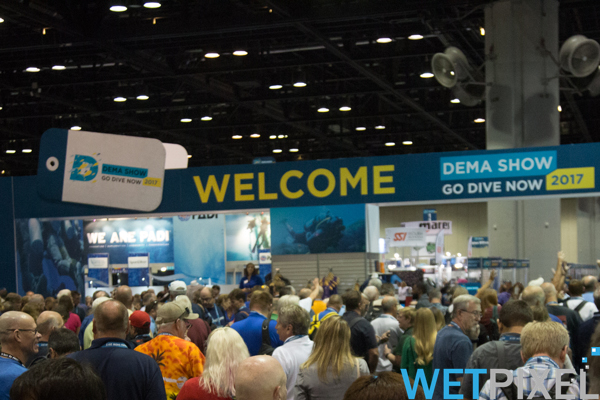
The Diving Equipment and Marketing Association (DEMA) hosts the world largest diving trade only show. For 2017, this is being held at the Orange County Convention Center, Orlando, Florida over 1 to 4 November. Traditionally, the show is the time when most manufacturers release and exhibit their new products, so attending gives a good idea of what is new in the industry. Wetpixel reports “live” from the event every year, to try and bring a flavour of the show to those that cannot attend.
Day 1
Drew Wohl, Lureen Ferretti and Adam Hanlon were on the show floor from its opening at 10. Our day consisted of meetings at manufacturers booths in which they kindly take some of their valuable time to talk us through their product ranges.
Ultralight Control Systems
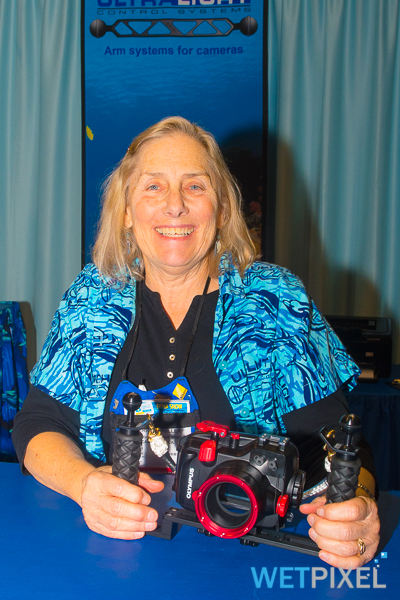
We met with Terry Schuler on the ULCS stand. She showed us a new version of their ubiquitous handle.
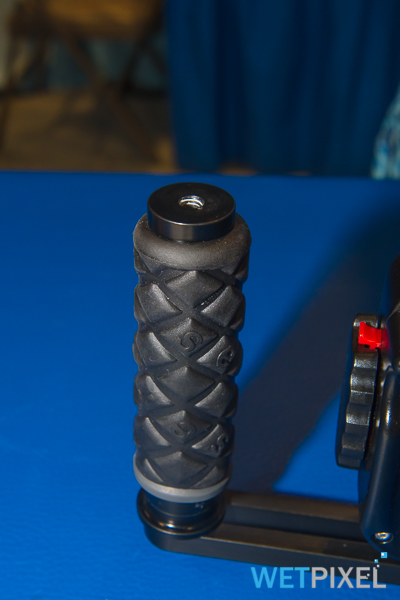
The ACH 1/4 has the grooved rubber grip, but now has a 1/4” thread on its top, allowing the attachment of a ball or other accessories.
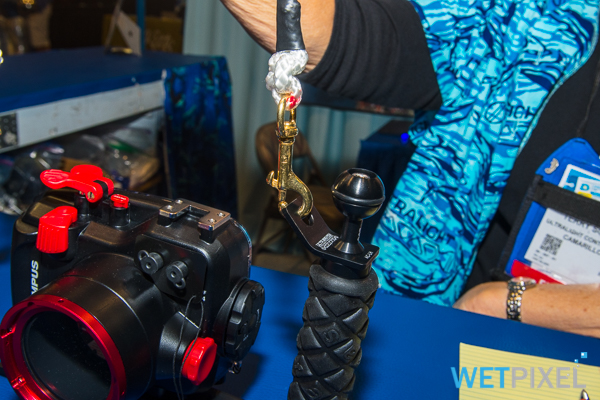
This also facilitates the attachment of lanyard holders, which can be either trapped under the ball head, or if these are not fitted, via a 1/4” bolt.
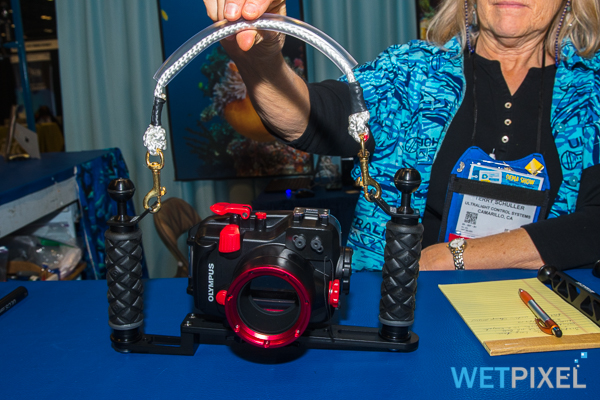
To go with these, ULCS now offer a lanyard, with two brass P clips and length of cord sleeved with tubing.
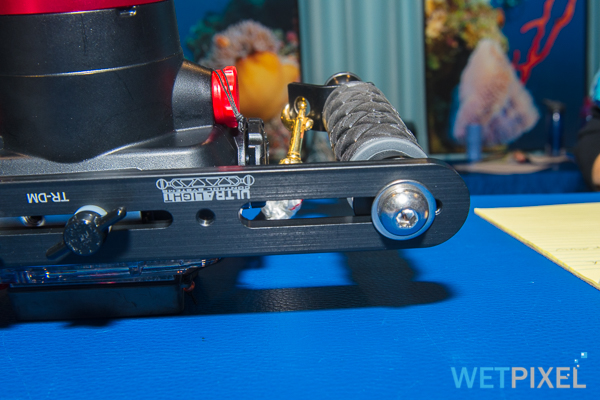
The new handles can be attached to existing Ultralight trays, with the TR-DM version allowing the handle to be adjusted laterally. Their digital handle has a fixed mounting.
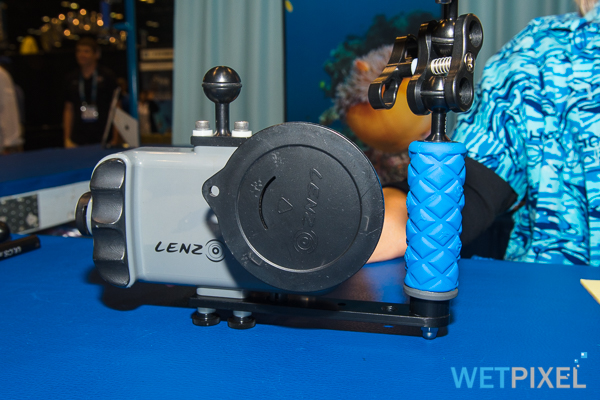
Terry showed me how the tray can be used with the Kraken smartphone housing, and the new Lenzo housings for the iPhone 6+ and 7+
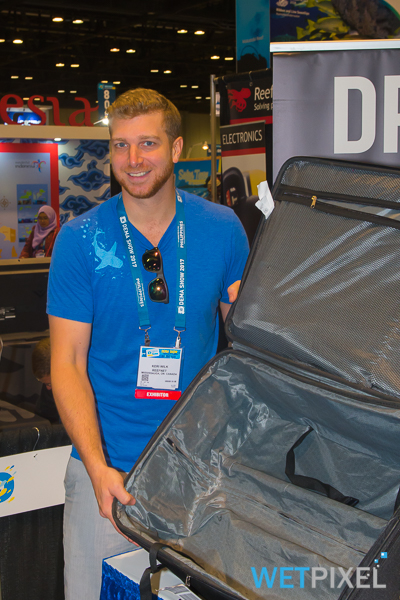
Keri Wilk’s “Mission to Dominica”
Many member of the Wetpixel community are probably aware that Keri Wilk has run trips to the island of Dominica over the past few years. The island suffered terrible deviation from hurricane Marie earlier this year and Keri is heading out to try and help recovery efforts. He is trying to fill his suitcase with supplies to assist the relief efforts that are being purchased with the proceeds from his YouCaring campaign. Please consider making a donation.
Right now, the island also really needs the income it derives from its tourism. With this end in mind, Keri has managed to organise a sperm whale trip that will be running from around 10 to 17 November, and has one space available. If you are free to travel soon, please contact Keri.
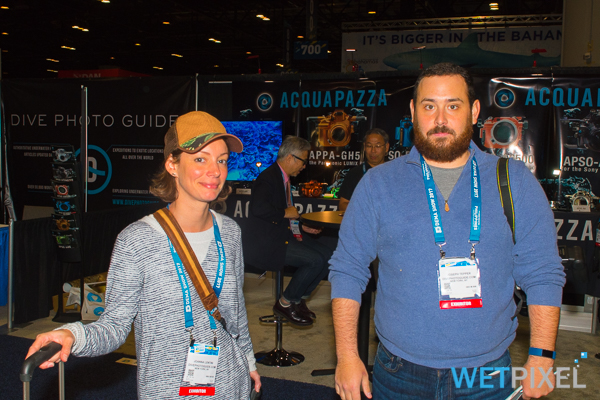
Nauticam
Nauticam’s burgeoning range is being exhibited on the shelf of the larger booths around the imaging resource area. Ryan Canon and Edward Lai took an extended time to talk us through it.
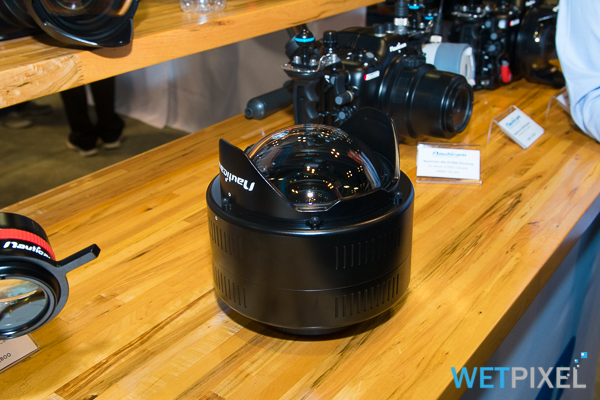
The first product they showed us is the Wide Angle Corrector Port (WACP). This is a water contact converter port that optically corrects the lens underwater. Ryan told us how it seems to work very well with cheaper lenses.
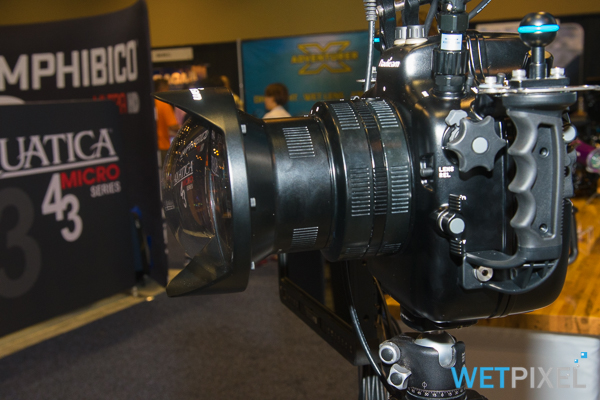
At the show, it was on a Canon 1D X Mark II with the Canon 28-80 f/3.5-5.6 V USM lens. Both the corners and middle of the frame are very sharp and it offers a 3 x zoom through, making it very versatile. For Nikon users, the 28-70mm f/3.5-4.5 D is a good choice. Both of these lenses are discontinued, but are available as economic choices pre-owned. At the 28 mm end, the WACP offers 130° field of view (FOV), around 105° at 35 mm and 90° at 50 mm. In fact, prime lenses at these focal lengths can also be used to achieve these FOVs too. Nauticam are in the process of testing 150 different lenses with the port, and there will be comprehensive compatibility information available shortly.
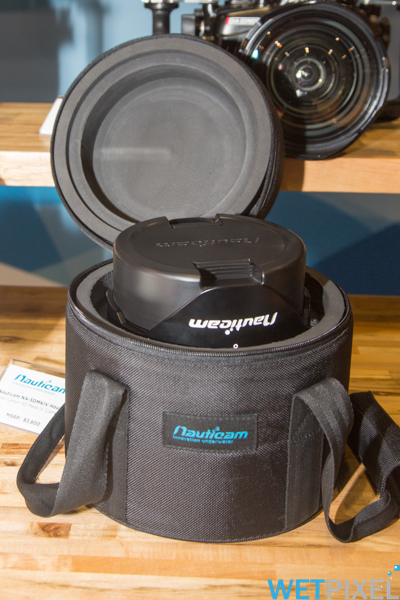
The WACP is being supplied in a sturdy carry case and with a removable flotation collar. It weighs 7 lbs in air and is 3 lbs negative without the collar, 0.5 lbs with the collar fitted. Shipping is imminent, and the retail price will be $3250. It is important to bear in mind that the WACP replaces (and outperforms) a wide angle lens, (typically) large dome port, and extension ring making the price point much better value than it first seems.
Ryan then took us through Nauticam’s SLR housing range. The company has focused on consistency and refinement, rather than new design features.
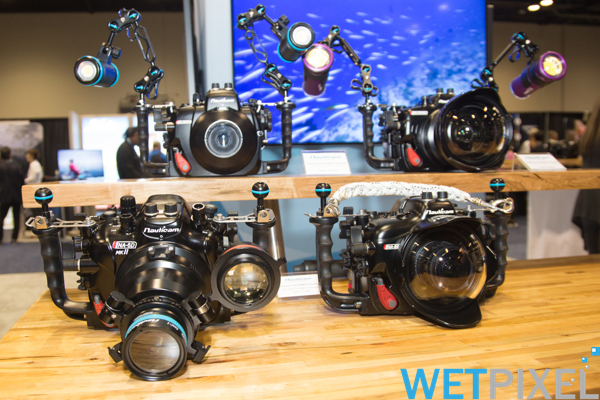
For Canon, Nauticam currently offers housings for 1D X Mark II, 6D Mark II, 80D, 5D Mark IV and 7D Mark II.
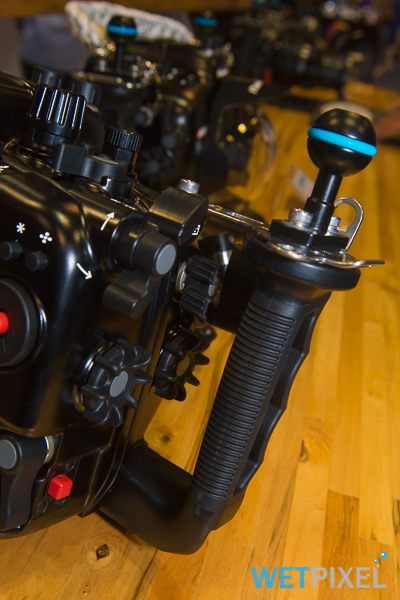
In general, control layouts are standardised, Ryan pointed out the dual thumb lever that accesses ISO and Focus area modes. In addition, the housing have a control that switches on or off Nauticam’s external TTL strobe trigger.
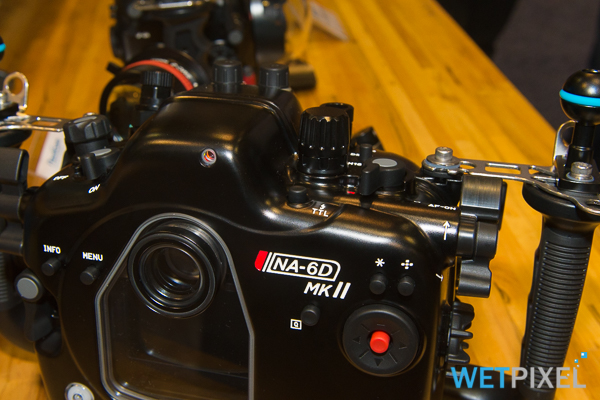
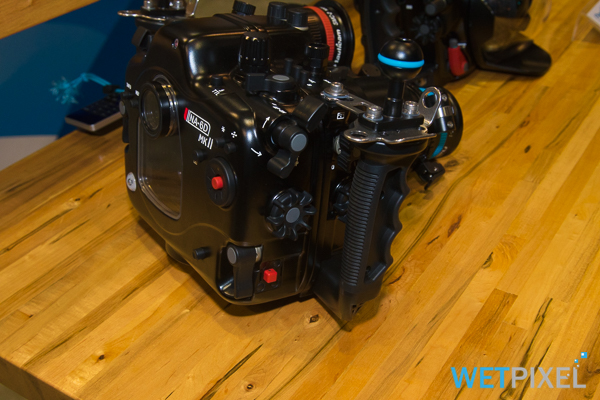
For Nikon SLR cameras, the story is similar.
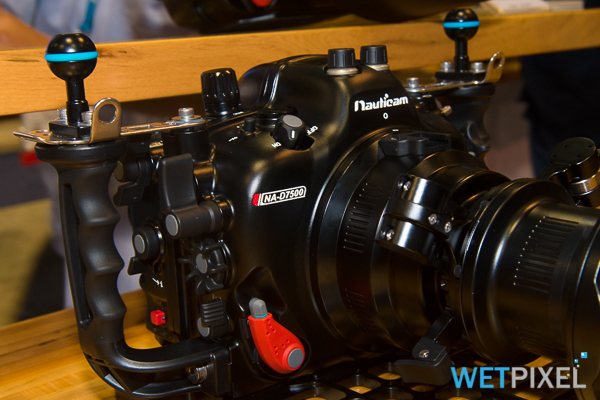
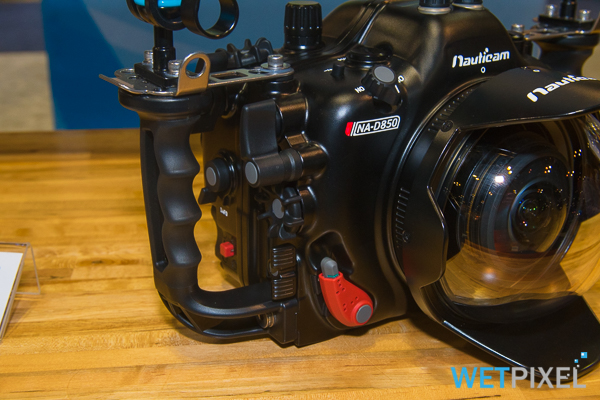
The new housings for the D7500 and D850 were on the booth and they both follow the Nauticam’s standard control layout.
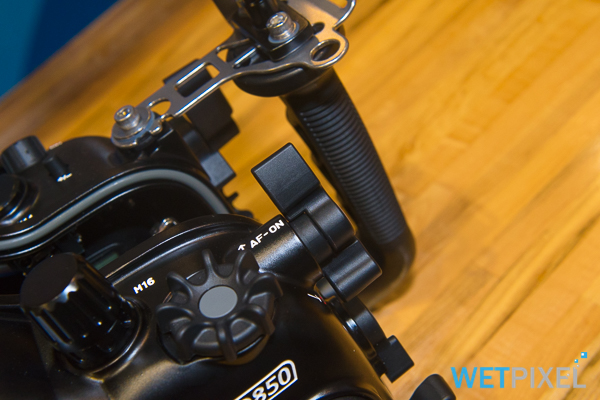
A slight change is that the AF ON levers and Record ON/OFF have been reversed. This moved the AF ON lever upwards, resulting in a more natural control position.
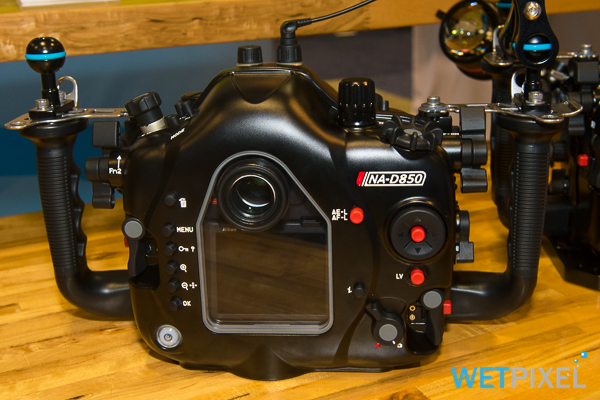
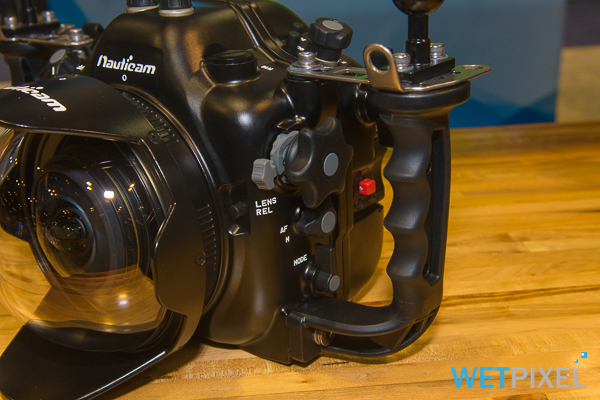
Nauticam offers the options of an internal electro optical manual converter TTL converter.
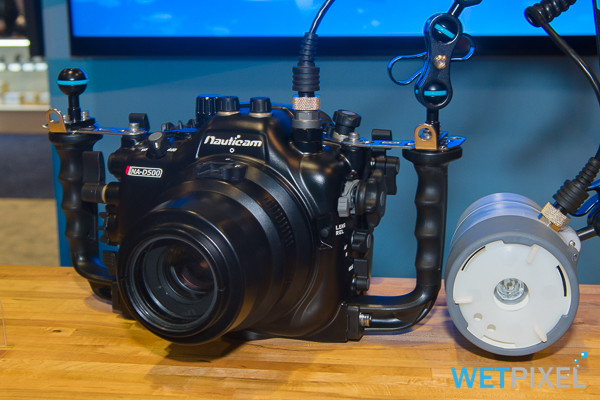
In the case of cameras without a pop up flash, the manual version is fitted as standard. These converters offer optical manual and TTL strobe triggering, along with electrical TTL and manual for Inon, Sea&Sea and Ikelite (DS160) strobes.
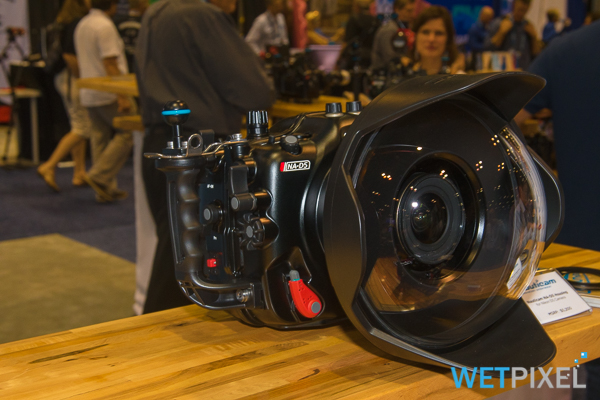
Nauticam now offers housings for Nikon D5, D850, D500 and D7500.
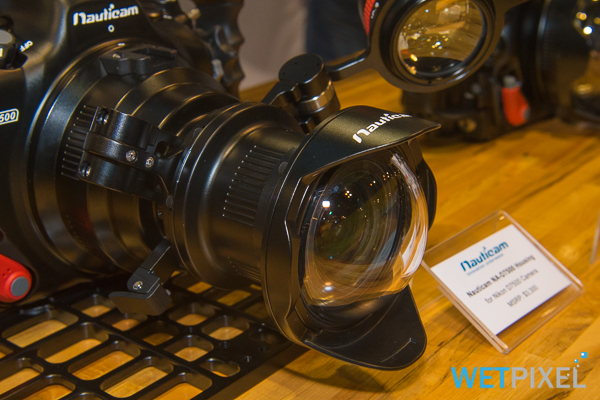
Attached to the D7500 was another new optic. This converts a 60 mm macro lens into a 150° fisheye lens that focuses on the front of its (small) dome.
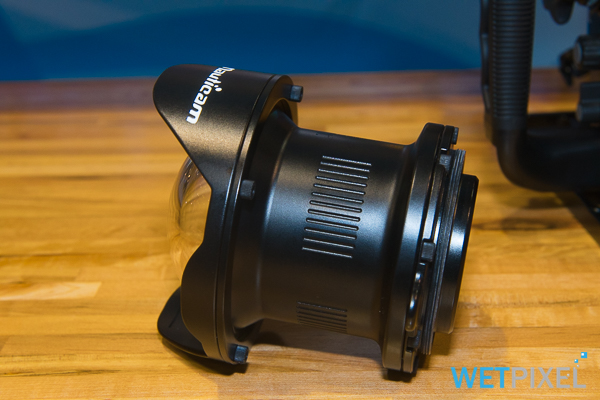
It attaches to the macro port with a 67mm thread or the Nauticam bayonet.
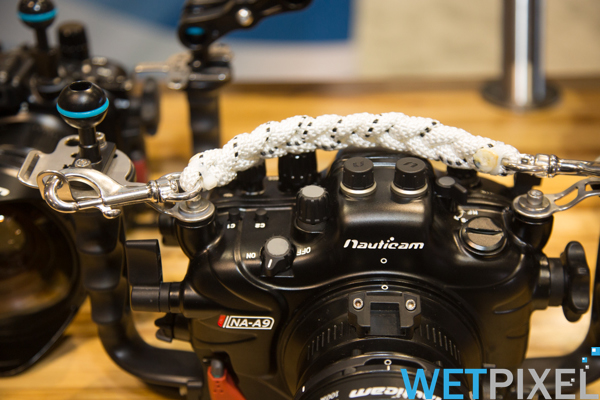
Moving on to mirrorless, Nauticam were showing their housing for the Sony a9.
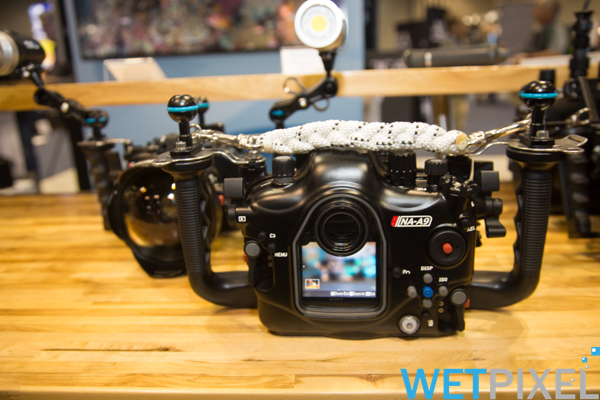
In image review mode, zoom in is activated via the AF ON lever and out via a thumb button.
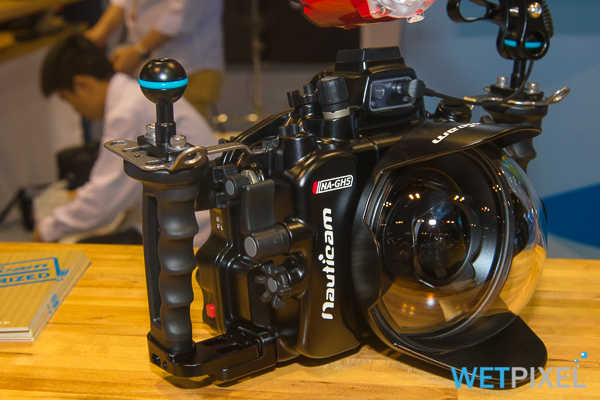
They also had their housings for the Panasonic GH5 and Sony a6500.
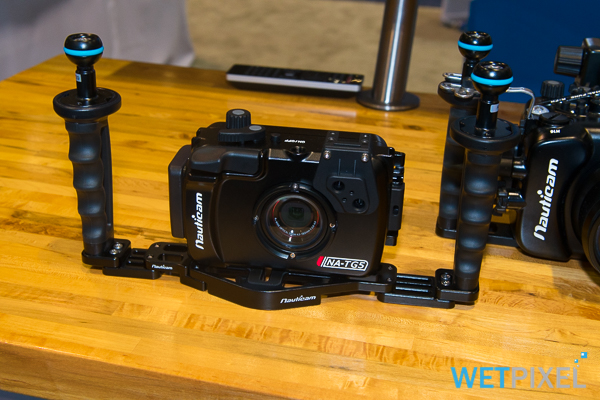
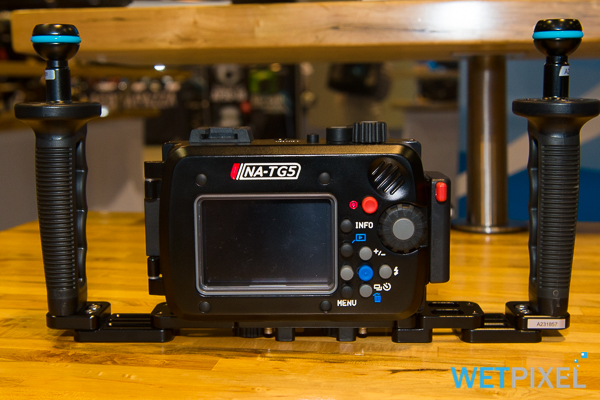
For Compact camera users, Nauticam had their housing for the Olympus TG-5
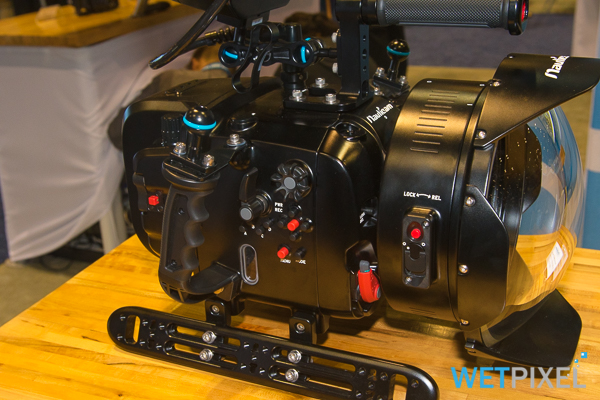
From the small to the considerably larger! Ryan showed us through new developments with their video housings.
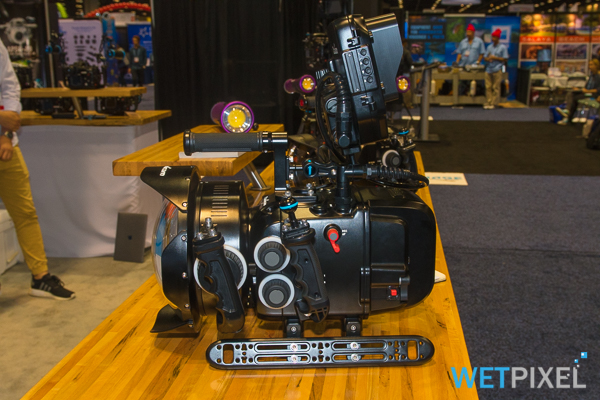
The existing RED Weapon LT housing is compatible with DSMC2 cameras including Epic Weapon, Scarlet, Raven, Weapon with Helium/Monstro and Weapon with Dragon.
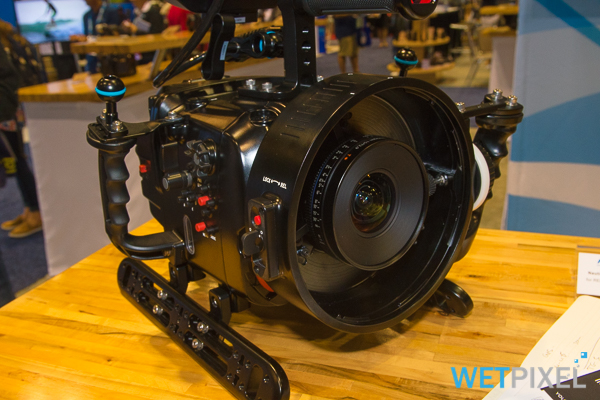
The housing is primarily designed for use with smaller SLR lenses, but Nauticam now offers an N120 to N200 port converter, that extends compatibility to Leica Summicron-C, Leica Thalia Master, Zeiss CP.2 and CP.3, Sigma Cine Prime, Tokina Vista Primes, Arri-Zeiss Ultra Primes and Canon CM-E series cinema lenses.
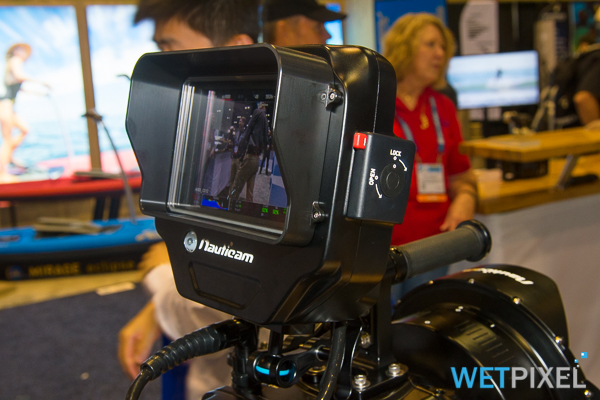
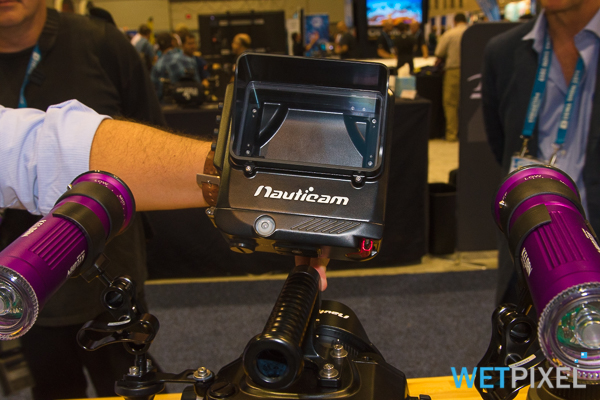
Monitor housings are now available for RED TOUCH 7” and 4.7”. Both have Edge Focus mode that takes information from RED Raw to emphasise critical focus.
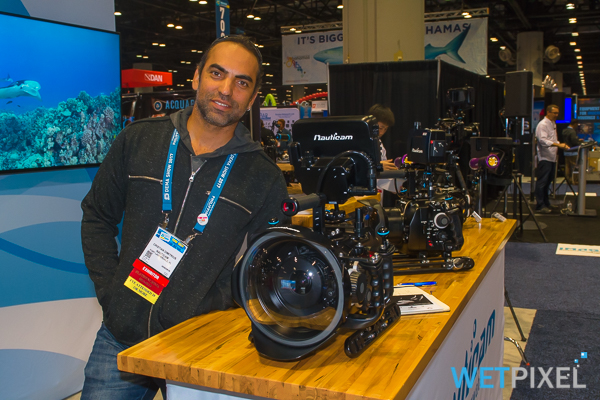
While on the subject of video, for those wanting to shoot with the Sony a7, it is possible to convert the N100 to N120 port system and then step it up to N200 for use with Cinema lenses.
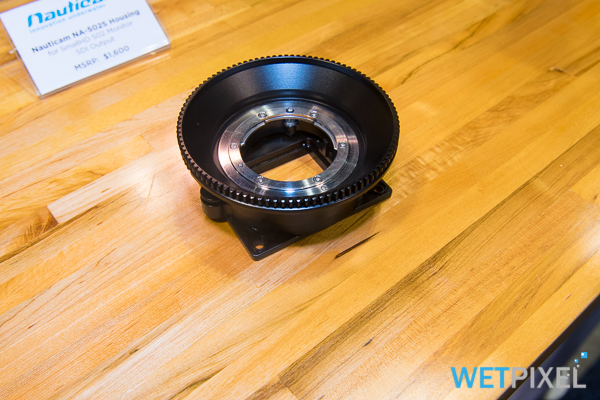
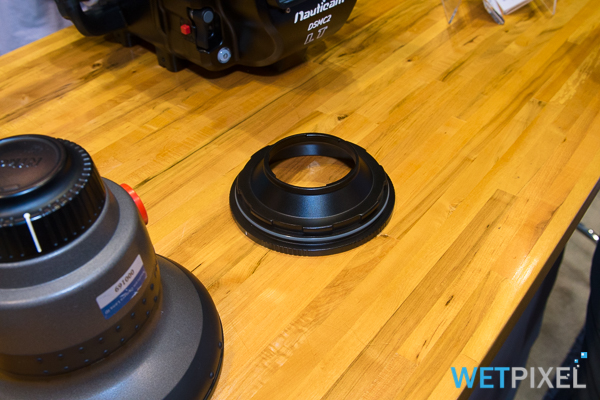
Nauticam has designed a simple converter allowing manual focus and iris for Nikonos RS lenses.
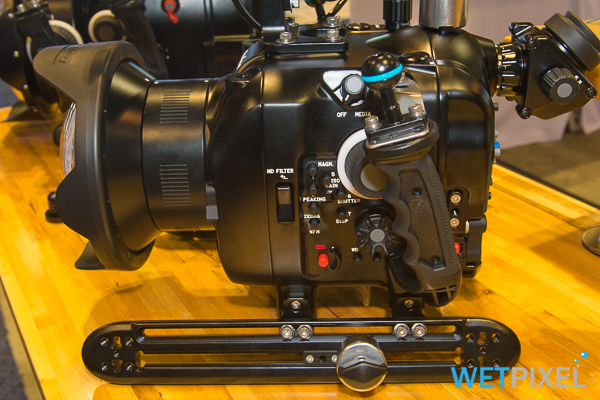
A new video housing that will ship in December is for the Canon C200.
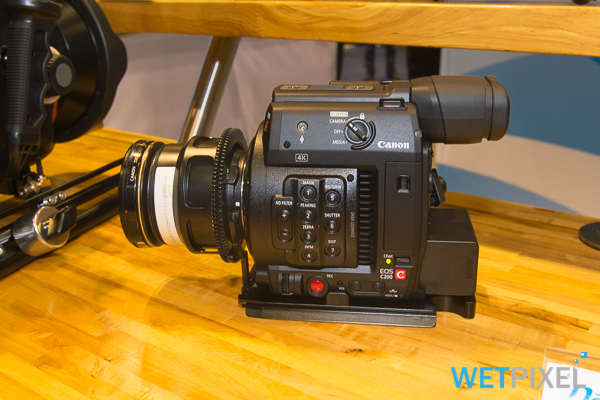
The camera has great color, internal ND filters, RAW Light codec and Dual Pixel AF. It outputs at 4K60p.
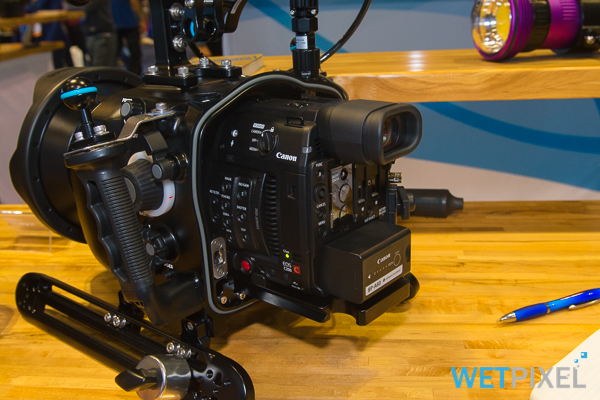
The housing features LANC trigger control (with manual backup), the N120 port system, and a new trim weight system.
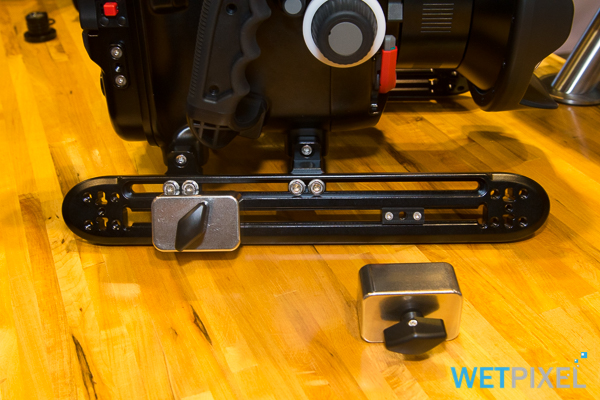
It will ship with trim weight skids, 2 x 250g and 2 x 500g weights.
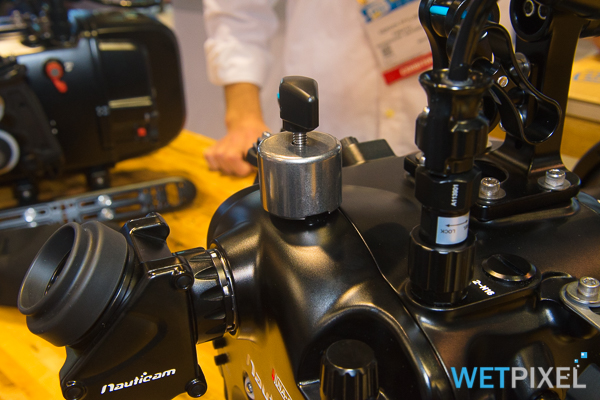
The weights can also be attached to threaded points on the housing body.
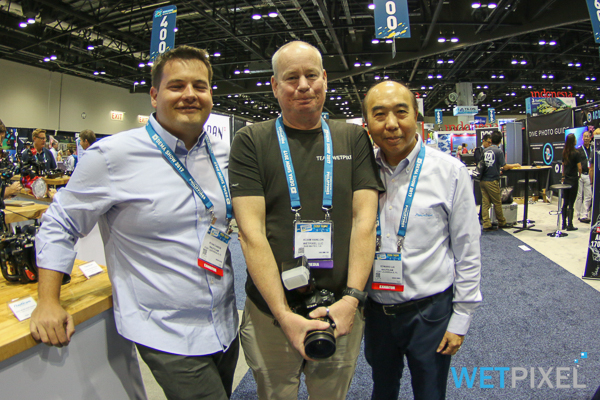
XIT404
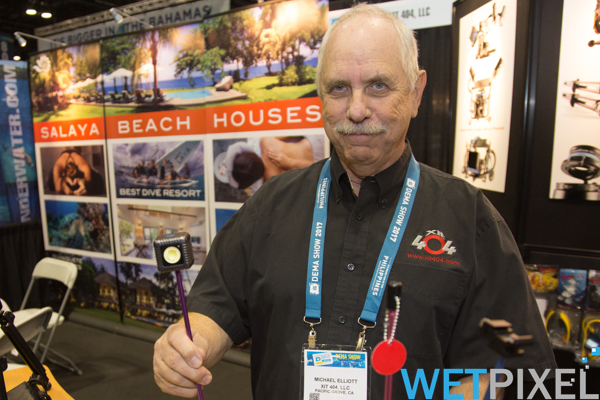
Jody and Mike Elliot showed us their new Dive Stick Plus.
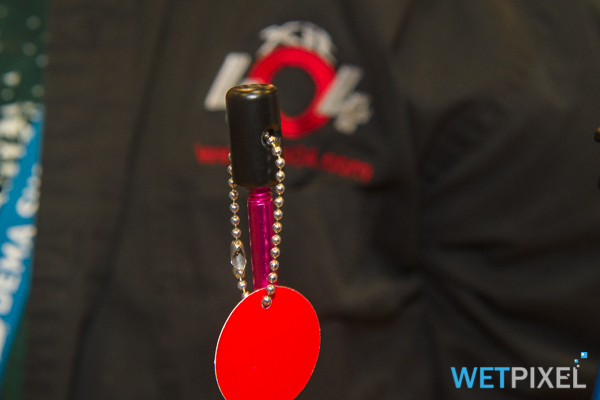
This has a 1/4” 20 thread on the top of it, and a sleeve that attaches to it, leaving an internal 1/4” 20 thread.
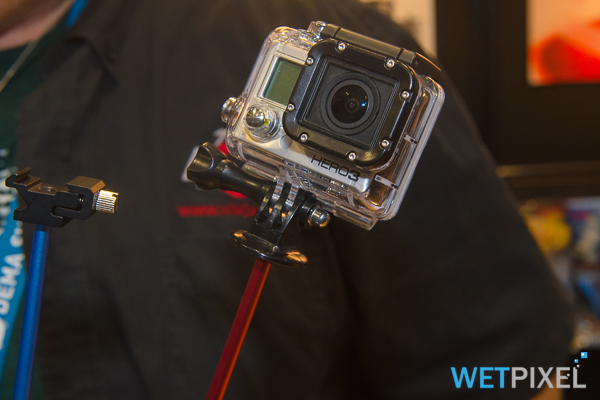
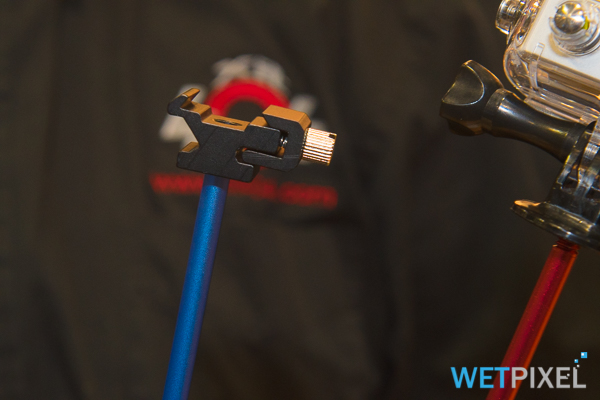
This allows the Stick to be used to support action cams or small lights. XIT 404 has also designed a cold shoe mount adaptor.
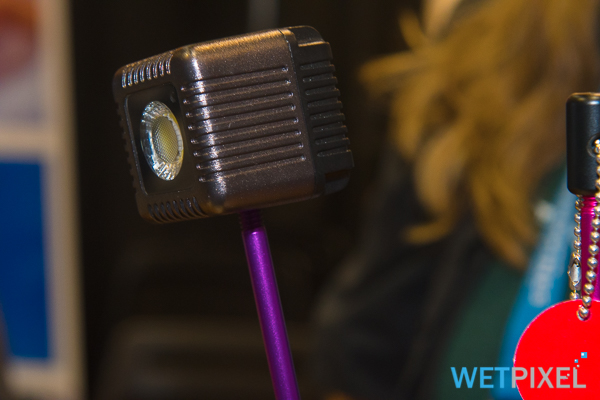
Another imminent new product is the Spike, that features a 1/4” 20 thread on a fluke type spike that can be pushed into a soft substrate. The fluke prevents it from rotating. Sadly the prototype has been delayed in transit, but we hope to see it later in the show.
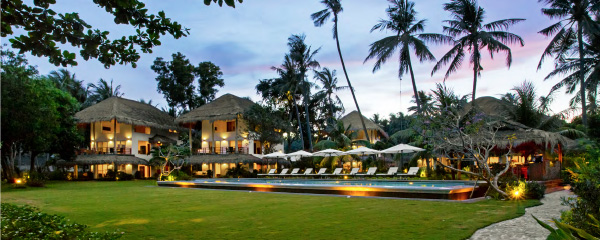
Jody mentioned that Salaya Beach Houses, their property in Dumaguete, Philippines, will be employing a resident marine biologist. They also hope to be conducting black water dives soon.
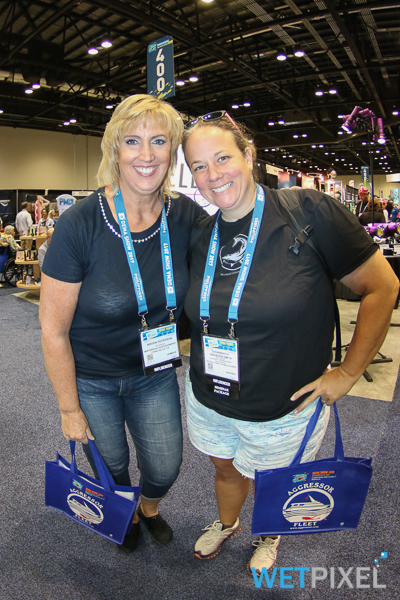
Image Resource Center
There is an ongoing series of talks being held at the image Resource Center in the middle of the imaging area of the show
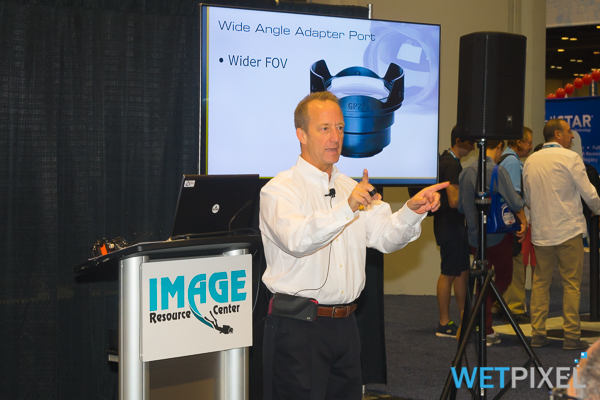
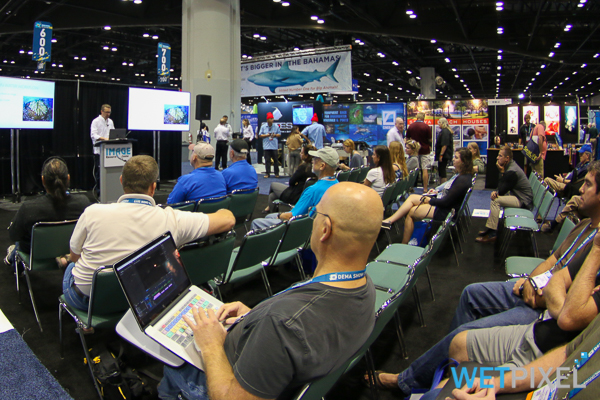
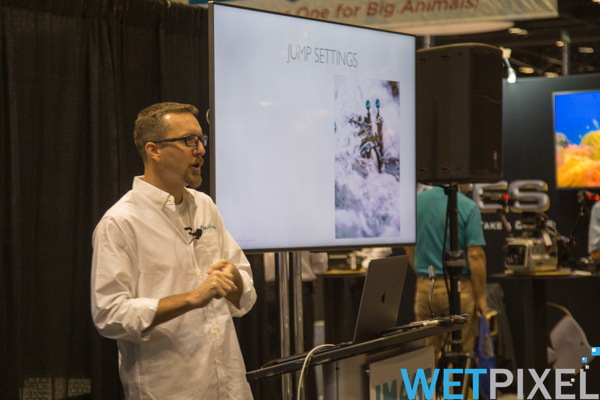
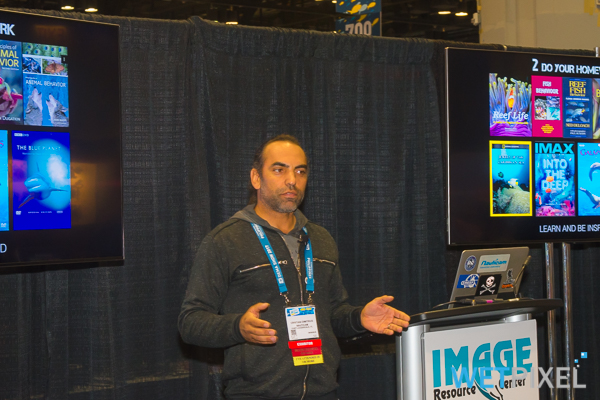
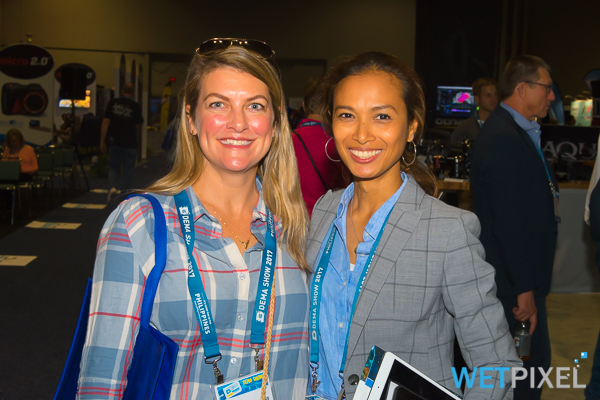
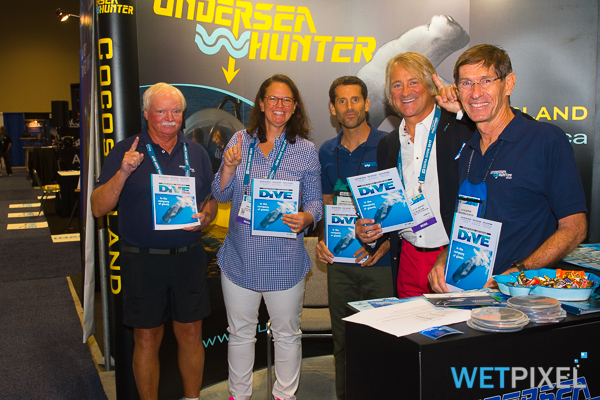
Gates Underwater Products
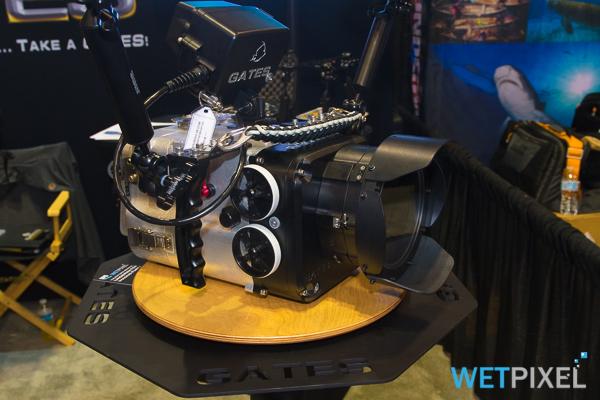
Gates announced their new Pro Explore housing earlier in the week and had a prototype of it in their booth.
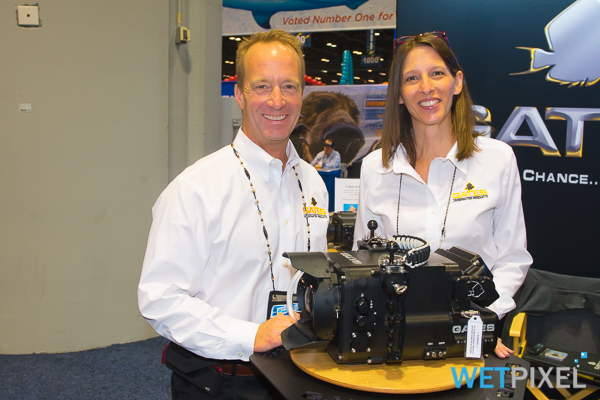
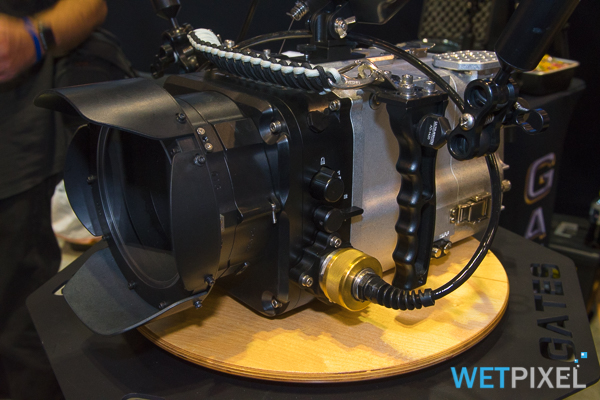
Designed specifically for RED DSMC2 8K cameras and small PL/SLR lenses, the “front end” is similar to that of the Pro Action housing and like it can be removed for access if required.
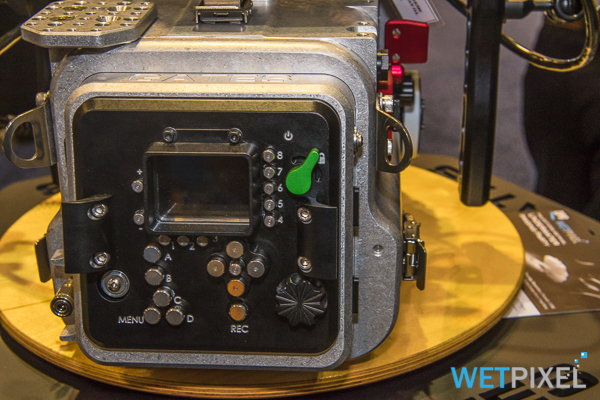
The rear section features a latched swing door that gives quick access to media and batteries. Mounted within the door is the REDMOTE controller that gives menu access to all camera controls. The housing has 14 assignable buttons.
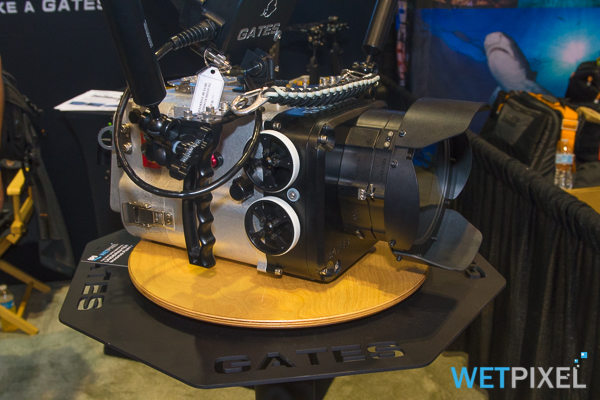
In essence the Pro Explore offers an intermediate model between the cinema oriented DEEP WEAPON housing and the action based Pro Action.
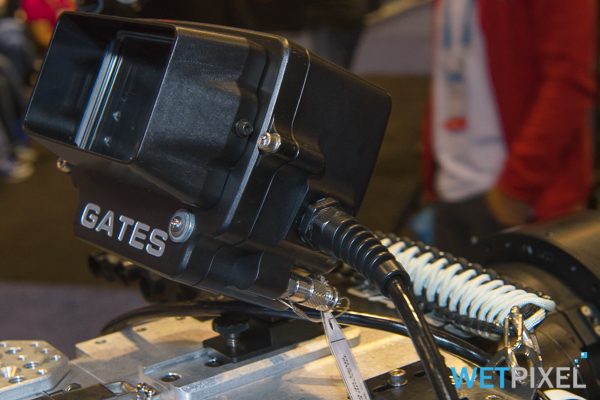
The Pro Explore has a port for surface SDI and Gig-E out/inputs. Gates offers housing for RED TOUCH 4.7”, 5” and 7” monitors, that are powered from the camera and offer Edge Focus mode.
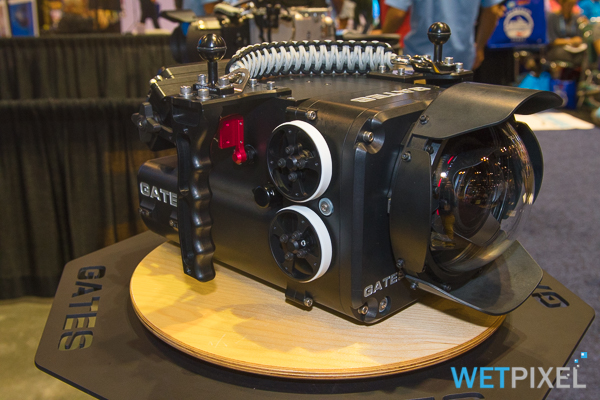
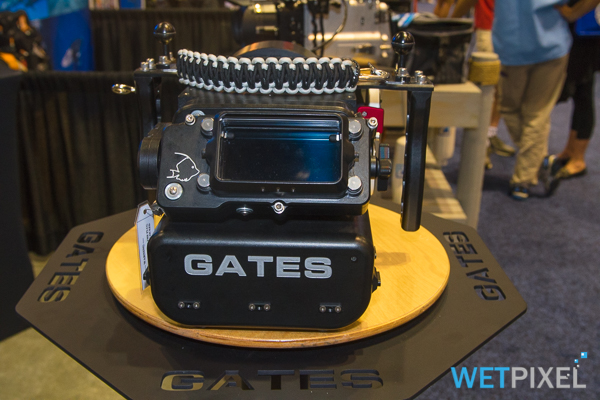
Another new product is a series of port rings. These offer a series of versatile options for different lenses.
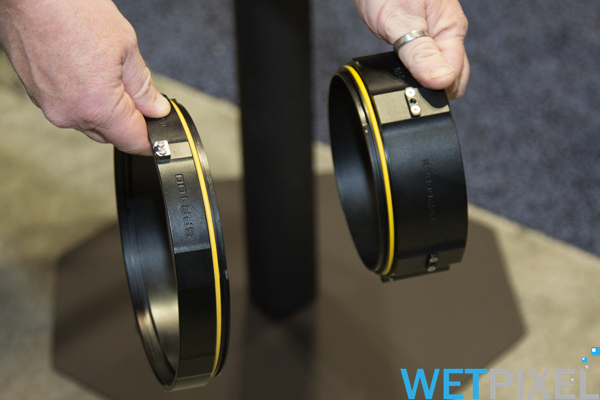
They are available in three diameters, the SPR 60 for Pro Action and Explore, SPR 80 for bigger housings like C300 and F55 and SPR110 for DEEP WEAPON. Each set of port rings is stackable giving multiple options.
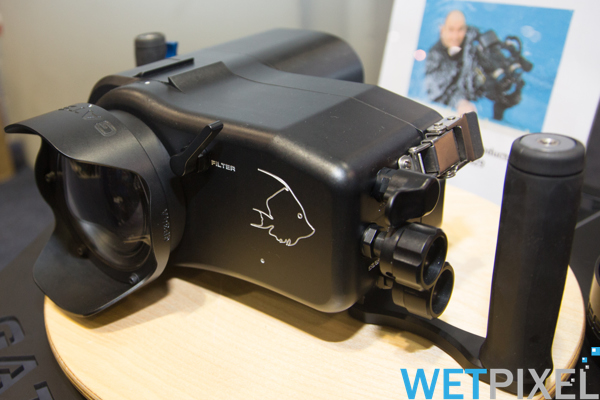
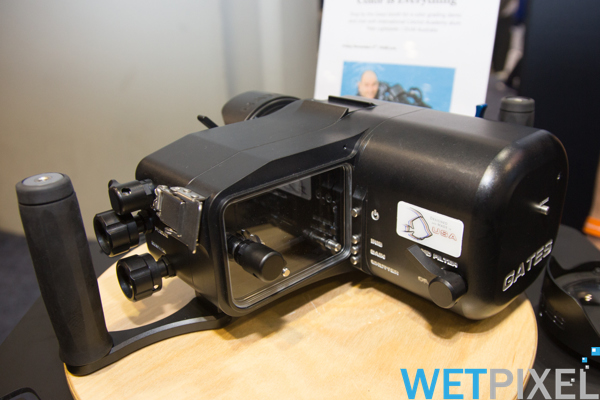
Lastly, Gates offers their AX700/Z90 housing for three 4K Sony camcorders: FDR-AX700, HXR-NX80, and PXW-Z90 models.
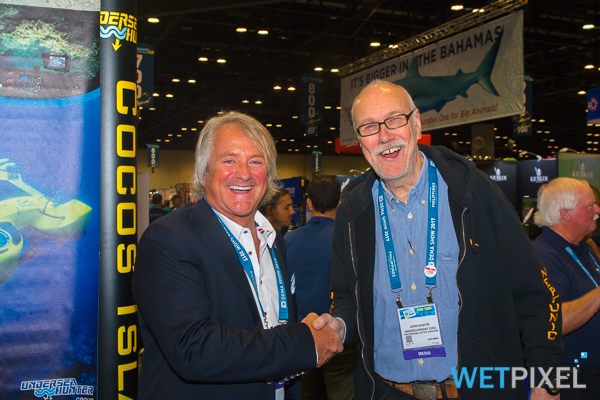
Keldan
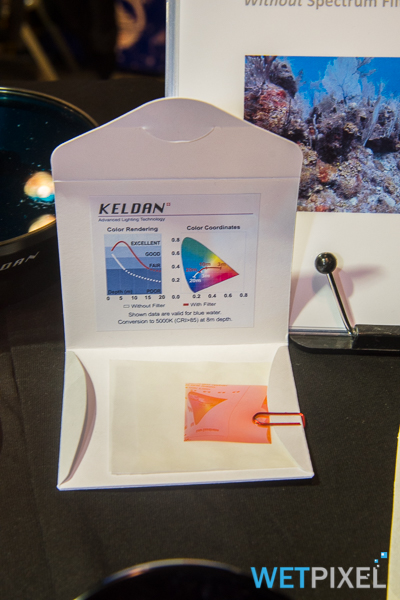
Daniel Keller showed me Keldan’s new Spectrum gel color correction filter. This dichroic filter is contract of multiple thin layers of material so will never bleach like a colored filter. It is designed to fit behind the lens.
It is the equivalent of an M2 filter, ideally suited for use for around 5 m (15 ft) through to 20 m (60 ft).
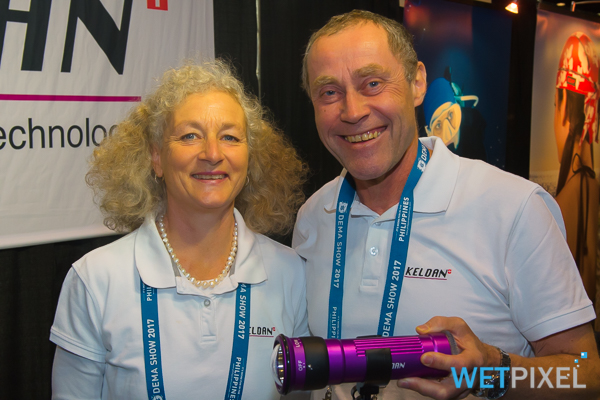
Daniel then discussed how white balance works increasing depths. Due to the effective absence of red at depth, filter use becomes more challenging. Daniel recommends that the white balance should be set at 20 m (60 ft) and retained at depths deeper then this for best results.
Another new product is a specific Spectrum filter for the Nauticam WWL-1 wet lens. This fits between the housing and the lens, and is constructed of polycarbonate with an anti scratch coating. It is available in 3 strengths: S1 (2 to 7 meters), M2 (5 to 12 meters) and D2 (7 to 15 meters).
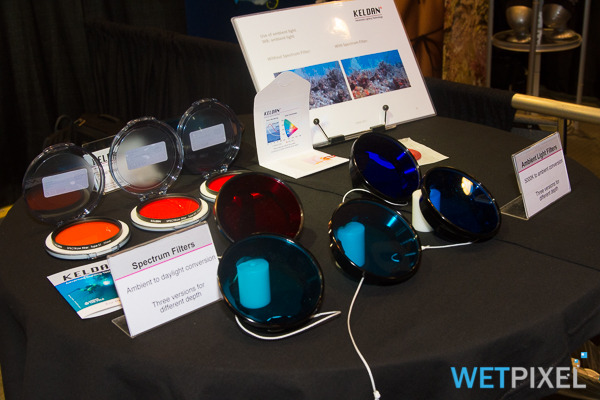
Keldan has also sourced a new material for the ambient light filters that has an anti scratch coating.
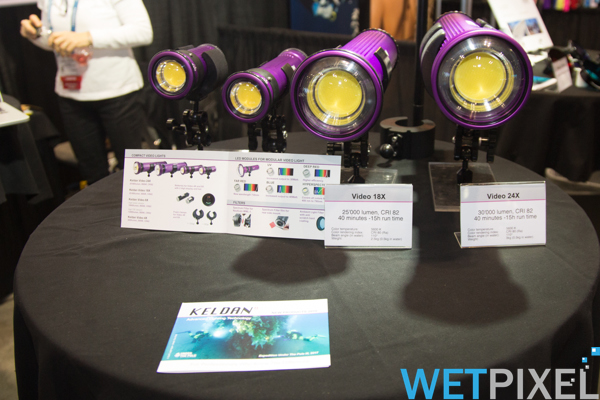
By sourcing more powerful batteries, all Keldan’s video lights have had increased outputs. The Luna 4X now offers 9000, the 8X, 1500, the 18X, 25,000 and the 24X 30,000 lumens. All the lights now have a standardised color temperature of 5600°K.
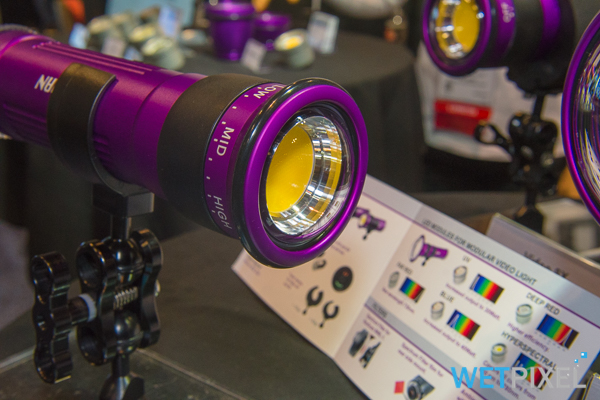
In addition, the light’s domes have been manufactured of a tougher material with a scratch resistant coating.
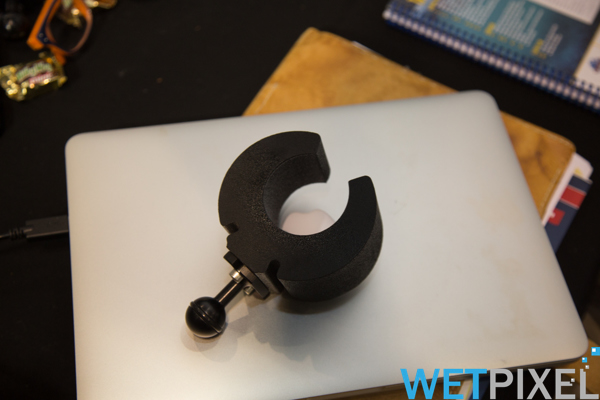
The new battery packs feature a graphical battery status display and a digital readout showing the burn time remaining.
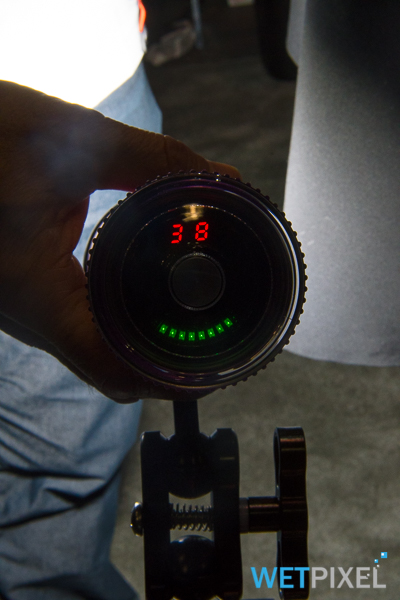
They are backward compatible with existing lights, but the older batteries are not compatible with the new lights.
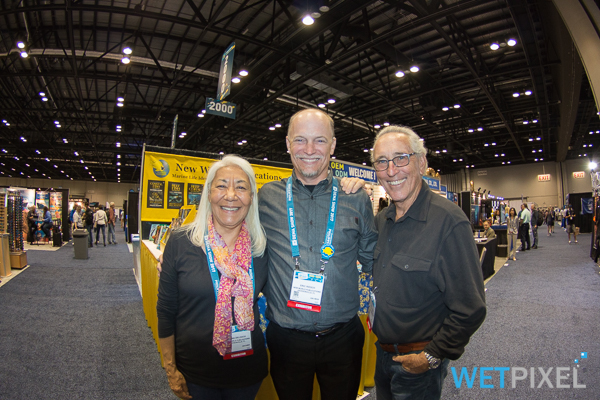
Acquapazza
We met with Toshiki Yamamoto and his translator Miki Kurimoto on the Acquapazza booth.
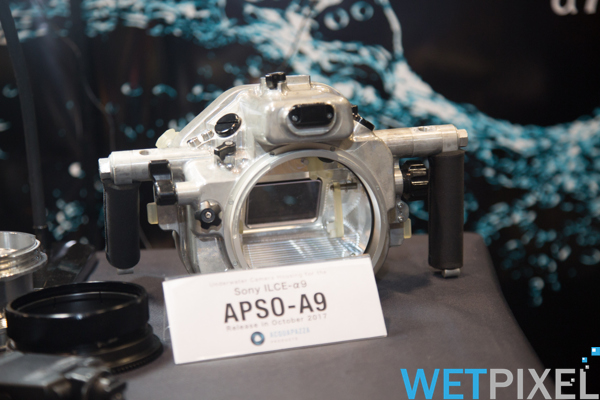
He was showing a prototype of a new housing for the Sony a9 mirrorless camera. In common with all the company’s housings, it features large 10 mm diameter buttons. The housing has a space for adding with a mini flash for triggering strobes, or a battery pack for extending video shooting life. It also features a 110 mm port throat to accommodate large diameter lenses and has handles that can be adjusted in angle to suit user preference or purpose.
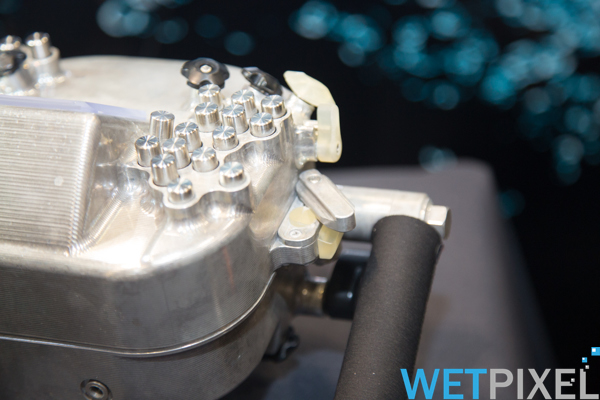
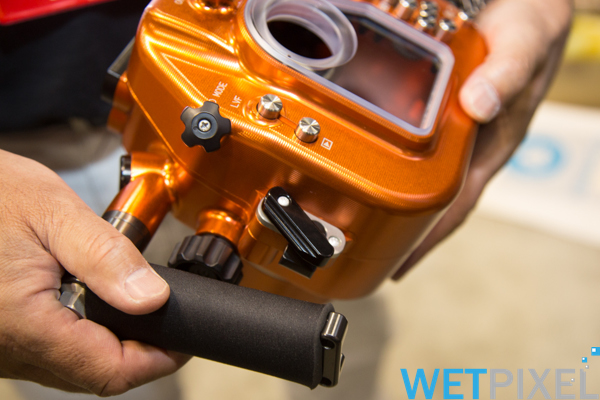
Lastly, it has the company’s new safety lock closures. Toshiki showed us how the Aquapazza zoom gears are constructed from two parts, one of which screws down to secure the gear in position.
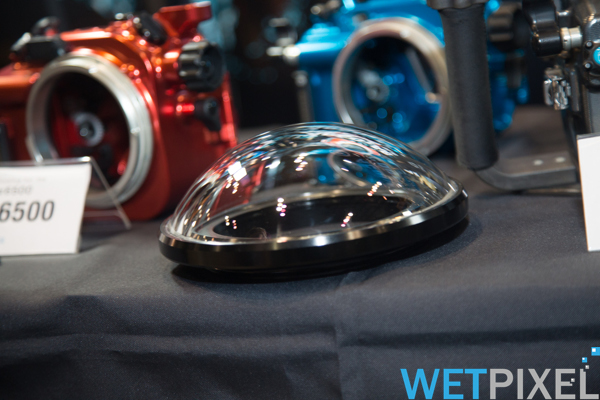
He then introduced us to his new 170 Dome Port LB. This 170 mm (7”) dome is depth rated to 200m and is supplied with a port shade.
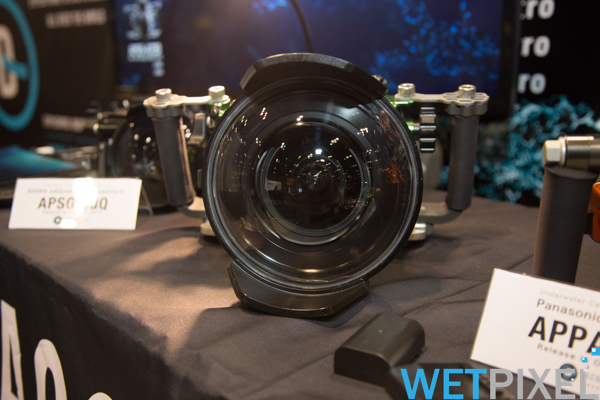
It has an internal anti reflection coating.
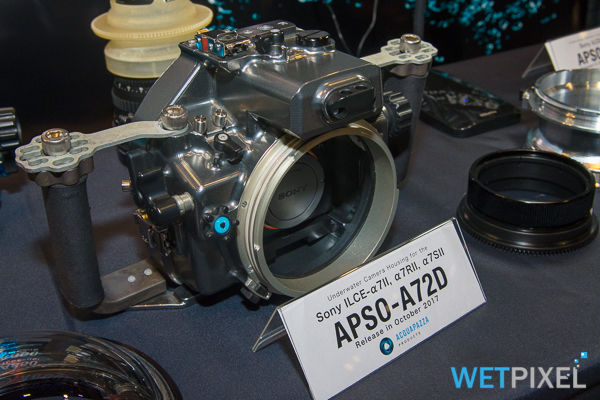
The port was designed for use on a specific deep diving project, and Toshiki showed me the APSO A72D housing for the Sony a7 Mark II. The “D” stands for Deep and it has a 200m rating too.
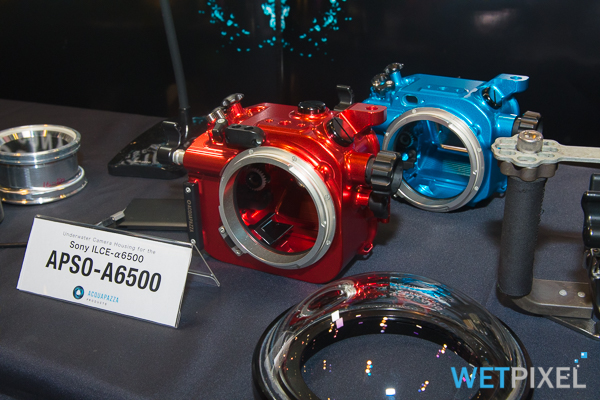
We then looked at the APSO-a6500 housing for the Sony a6500. This is equipped with a slot that can take a battery pack under the camera.
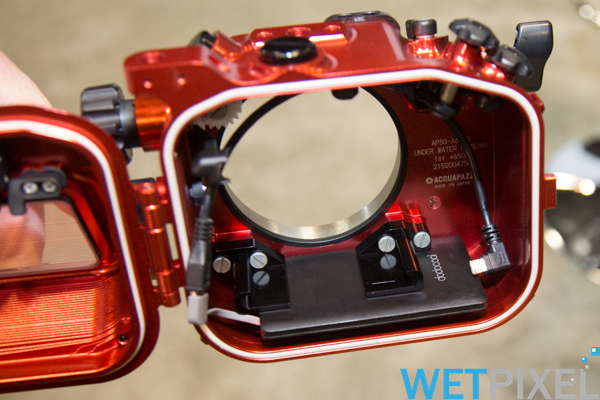
The size of this slot was deliberately chosen to ensure compatibility with as many different types of battery pack as possible.
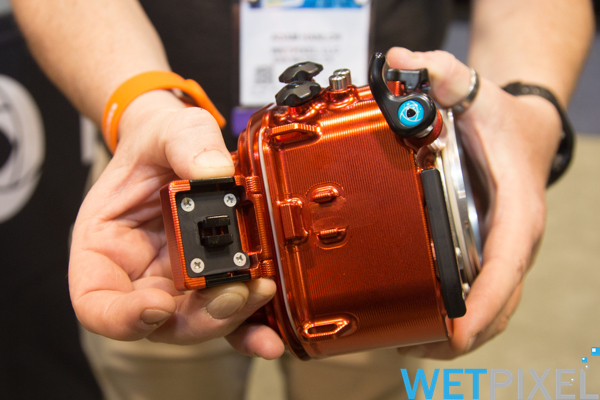
The latching mechanism is constructed of aluminum for strength and closes with an audible click.
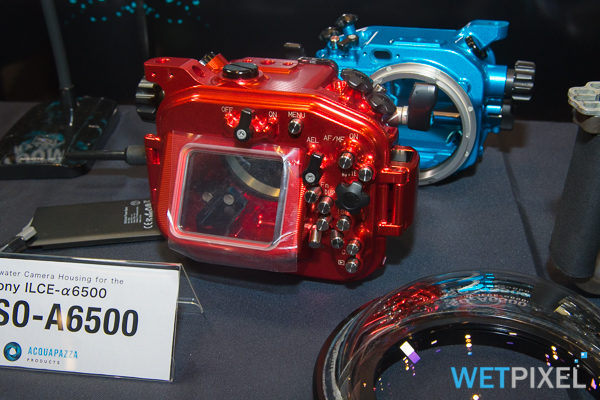
It has M14 and M16 accessory ports and all the controls are laser etched with their function.

Next up was the housing for the Sony RX100 Mark V. There are two version of the APSO RX100M5, one aimed at still shooters and the other at video.
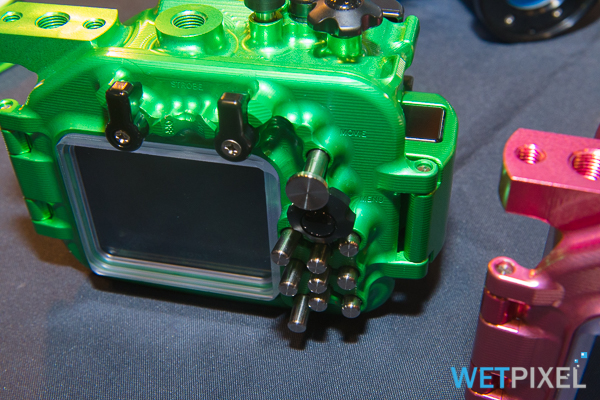
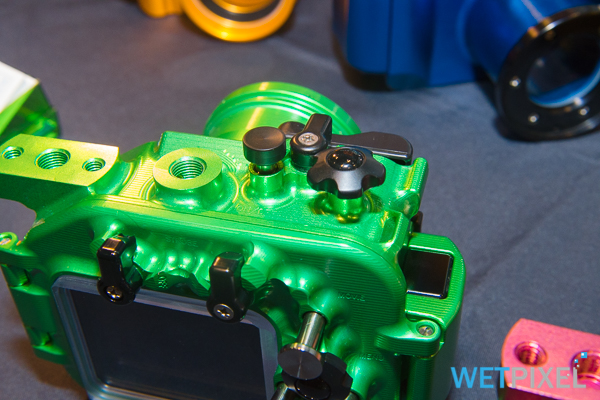
The latter has oversized record and on/off buttons.
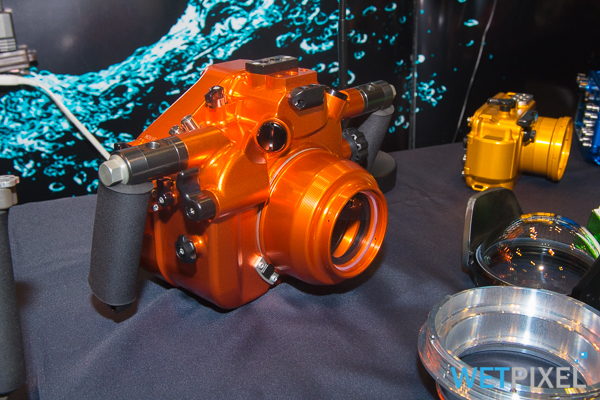
The Acquapazza APSO-GH5 features the safety locking system and adjustable angle grips.

It can accommodate either the Panasonic mini flash, or Acquapazza’s LED mini strobe for optical flash triggering. Again, it is controls are laser etched to show functions. Toshiki showed us a small dome designed for the Panasonic 8 mm fisheye and the Panasonic 7-14mm can be used with the larger 170 mm dome.
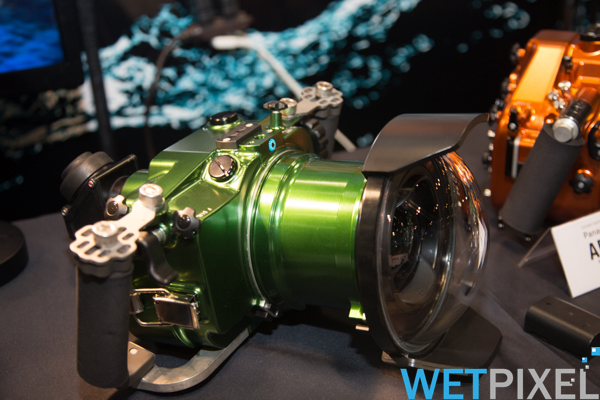
Acquapazza has supported the Sigma Foveon sensor cameras and the APSO-sDQ is for the Sigma SD Quattro. Toshiki was warned that Sigma were planning a wide diameter 14 mm lens, so held off his production for 6 months.
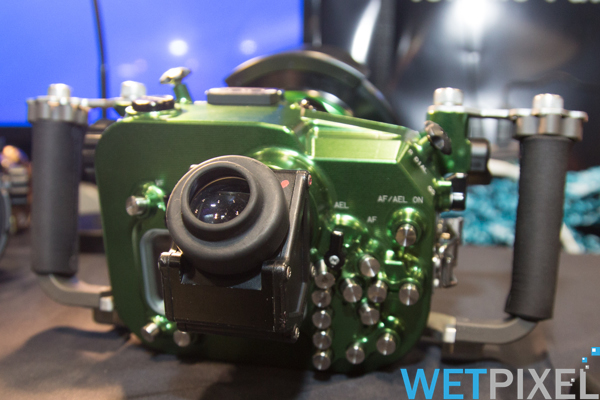
The housing has a wide throat to accommodate this and as the lens tends to droop due to its weight, so the company has designed a removable pillow that attaches to the throat of the dome port to support the front end of the lens.
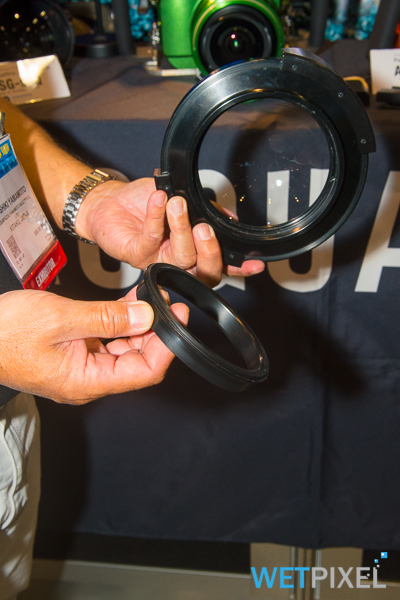
Page 1: Ultralight, Nauticam, XIT404, Gates, Keldan, Acquapazza.
Page 2: Seacam, Subal, Isotta, Easydive, Aquatica, Sea&Sea.
Page 3: Wetpixel/DPG Underwater Imaging Party.
Page 4: iDive, VRTUL, Pelagic Fleet, Cinebags, SAGA.
Page 5: Backscatter, XIT404, Fisheye, Ikelite, Fantasea, Inon.